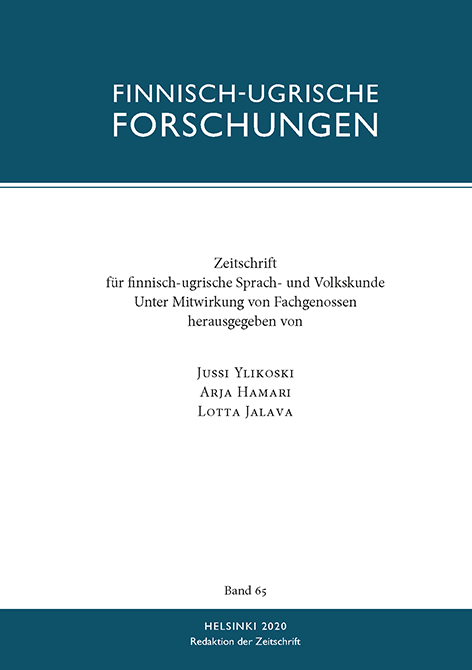Fresh views on the early history of Indo-European and its relation to Uralic
DOI:
https://doi.org/10.33339/fuf.99932Abstract
Besprechung Kloekhorst, Alwin & Pronk, Tijmen (eds.). 2019. The precursors of Proto-Indo-European: The Indo-Anatolian and Indo-Uralic hypotheses (Leiden Studies in Indo-European 21). Leiden & Boston: Brill. viii + 235 pp.
References
Adiego, Ignasi-Xavier. 2016. Anatolian languages and Proto-Indo-European. Veleia 33. 49–64. https://doi.org/10.1387/veleia.16819
Aikio, Ante (Luobbal Sámmol Sámmol Ánte). 2014. The Uralic-Yukaghiric lexical correspondences: Genetic inheritance, contact of chance resemblance? Finnisch-Ugrische Forschungen 62. 7–76. https://doi.org/10.33339/fuf.86078
Aikio, Ante (Luobbal Sámmol Sámmol Ánte). 2015. The Finnic ‘secondary e-stems’ and Proto-Uralic vocalism. Journal de la Société Finno-Ougrienne 95. 26–66. https://doi.org/10.33340/susa.82642
Beekes, Robert Stephen Paul. 2011. Comparative Indo-European linguistics. Second edition. Revised and corrected by Michiel de Vaan. Amsterdam & Philadelphia: John Benjamins. https://doi.org/10.1075/z.172
Bezlaj, France. 1977–2007. Etimološki slovar slovenskega jezika I–V. Ljubljana: SAZU ZRC.
Collinder, Björn. 1960. Comparative grammar of the Uralic languages. Stockholm: Almqvist & Wiksell.
Čop, Bojan. 1975. Die indogermanische Deklination im Lichte der indouralischen vergleichenden Grammatik. Ljubljana: SAZU.
Helimski, Eugene. 2005. The 13th Proto-Samoyedic vowel. In Wagner-Nagy, Beáta (ed.), Mikola-konferencia 2004, 27–40. Szeged: SzTE.
Holopainen, Sampsa. 2019. Indo-Iranian borrowings in Uralic: Critical overview of the sound substitutions and distribution criterion. Helsinki: University of Helsinki. http://hdl.handle.net/10138/307582 (Doctoral dissertation.)
Honti, László. 2012. Das Zeitalter und die Entstehung der Personalpronomina mit velaren Vokalen. In Hyytiäinen, Tiina & Jalava, Lotta & Saarikivi, Janne & Sandman, Erika (eds.), Per Urales ad Orientem: Iter polyphonicum multilingue. Festskrift tillägnad Juha Janhunen på hans sextioårsdag den 12 februari 2012 (Mémoires de la Société Finno-Ougrienne 264), 121–129. Helsinki: Finno-Ugrian Society.
Hyllested, Adam. 2009. Internal reconstruction vs. external comparison: The case of the Indo-Uralic laryngeals. In Olander, Thomas & Rasmussen, Jens Elmegård (eds.), Internal reconstruction in Indo-European: Methods, results, and problems (Copenhagen studies in Indo-European 3), 3–28. Copenhagen: Museum Tusculanum Press.
Janhunen, Juha. 1981. Uralilaisen kantakielen sanastosta. Journal de la Société Finno-Ougrienne 77. 219–274.
Janhunen, Juha. 1982. On the structure of Proto-Uralic. Finnisch-Ugrische Forschungen 44. 23–42.
Kallio, Petri. 2004. Tocharian loanwords in Samoyed? In Hyvärinen, Irma & Kallio, Petri & Korhonen, Jarmo (eds.), Etymologie, Entlehnungen und Entwicklungen: Festschrift fur Jorma Koivulehto zum 70. Geburtstag (Mémoires de la Société Neophilologique de Helsinki 63), 129–137. Helsinki: Société Neophilologique.
Kallio, Petri. 2015. Nugae Indo-Uralicae. Journal of Indo-European Studies 43. 368–375.
Kassian, Aleksei & Zhivlov, Mikhail & Starostin, George. 2015. Proto-Indo-European-Uralic comparison from the probabilistic point of view. Journal of Indo-European Studies 43. 301–347.
KESKJ = Лыткин, В. И. & Гуляев, Е. С. 1999. Краткий этимологический словарь коми языка. Сыктывкар: Коми книжное издательство.
Kloekhorst, Alwin. 2008a. Etymological dictionary of the Hittite inherited lexicon (Leiden Etymological Dictionary Series, Vol 5). Leiden & Boston: Brill.
Kloekhorst, Alwin. 2008b. Some Indo-Uralic aspects of Hittite. Journal of Indo-European studies 36. 88–95.
Kloekhorst, Alwin. 2016. The Anatolian stop system and the Indo-Hittite hypothesis. Indogermanische Forschungen 121. 213–247. https://doi.org/10.1515/if-2016-0013
Kloekhorst, Alwin. 2018. Anatolian evidence suggests that the Indo-European laryngeals *h₂ and *h₃ were uvular stops. Indo-European linguistics 6. 69–94. https://doi.org/10.1163/22125892-00601003
Kümmel, Martin. 2007. Konsonantenwandel: Bausteine zu einer Typologie des Lautwandels und ihre Konsequenzen für die vergleichende Rekonstruktion. Wiesbaden: Reichelt.
Matasović, Ranko. 2012. Areal typology of PIE: the case for Caucasian connections. Transactions of the Philological Society 110. 283–310. https://doi.org/10.1111/j.1467-968x.2012.01309.x
Mikola, Tibor. 1988. Geschichte der samojedischen Sprachen. In Sinor, Denis (ed.), The Uralic languages: Description, history and foreign influences (Handbuch der Orientalistik 8: Handbook of Uralic studies 1), 219–263. Leiden: E. J. Brill.
MSzFE = Lakó, György. 1971–1978. A magyar szókészlet finnugor elemei. Budapest: Akadémiai Kiadó.
Olander, Thomas. 2019. Indo-European cladistic nomenclature. Indogermanische Forschungen 124. 231–244. https://doi.org/10.1515/if-2019-0008
Pooth, Roland & Kerkhof, Peter Alexander & Kulikov, Leonid & Barđdal, Jóhanna. 2019. The origin of non-canonical case marking of subjects in Proto-Indo-European. Indogermanische Forschungen 124. 245–263. https://doi.org/10.1515/if-2019-0009
Rasmussen, Jens Elmegård. 2005. Der Akkusativ auf *-m im Indogermanischen und Uralischen: Kontakt oder Erbe? In Meiser, Gerhadt & Hackstein, Olav (eds.), Sprachkontakt und Sprachwandel: Akten der XI. Fachtagung der Indogermanischen Gesellschaft, 17.–23. September 2000, Halle an der Saale, 525–535. Wiesbaden: Reichert.
Rieken, Elisabeth. 2009. Der Archaismus des Hethitischen: Eine Bestandsaufnahme. Incontri Linguistici 32. 37–52.
Sárosi, Zsófia. 2003. Az ősmagyar kor: morfématörténet. In Kiss, Jenő & Pusztai, Ferenc (eds.), Magyar nyelvtörténet, 129–173. Budapest: Osiris Kiadó.
Serangeli, Matilde. 2019. Introduction. In Serangeli, Matilde & Olander, Thomas (eds.), Dispersals and diversification: Linguistic and archaeological considerations on the early stages of Indo-European, 1–20. Leiden & Boston: Brill. https://doi.org/10.1163/9789004416192_002
Simon, Zsolt. 2019. The Anatolian stop system and the Indo-Anatolian hypothesis – revisited. In Serangeli, Matilde & Olander, Thomas (eds.), Dispersals and diversification: Linguistic and archaeological considerations on the early stages of Indo-European, 236–250. Leiden & Boston: Brill. https://doi.org/10.1163/9789004416192_013
UEW = Redei, Károly. 1988. Uralisches Etymologisches Wörterbuch. Band I–II: Unter Mitarbeit von Marianne Bakró-Nagy, Sándor Csúcs, István Erdélyi †, László Honti, Éva Korenchy †, Éva K. Sal und Edit Vértes, Band III: Register Zusammengestellt von Attila Dobó und Éva Fancsaly. Wiesbaden: Harrassowitz.
Zhivlov, Mikhail. 2014. Studies in Uralic vocalism III. Journal of Language Relationship / Вопросы яызыкого родства 12. 113−148. https://doi.org/10.31826/jlr-2015-120109
Zhivlov, Mikhail. 2017. Отражение ностратических огубленных гласных в индоевропейском. In Саенко, М. Н. (ed.), Памяти В. М. Иллич-Свитыча: Материалы круглого стола. Москва: Институт славяноведения РАН.
Zhivlov, Mikhail. 2018. Прасамодийский *s – фонология и фонетика. (Presentation at Семинар по сравнительно-исторической фонетике самодийских языков, Институт языкознания РАН, 25.–26.3.2018.) https://www.academia.edu/38048065/Прасамодийский_s_фонология_и_фонетика




